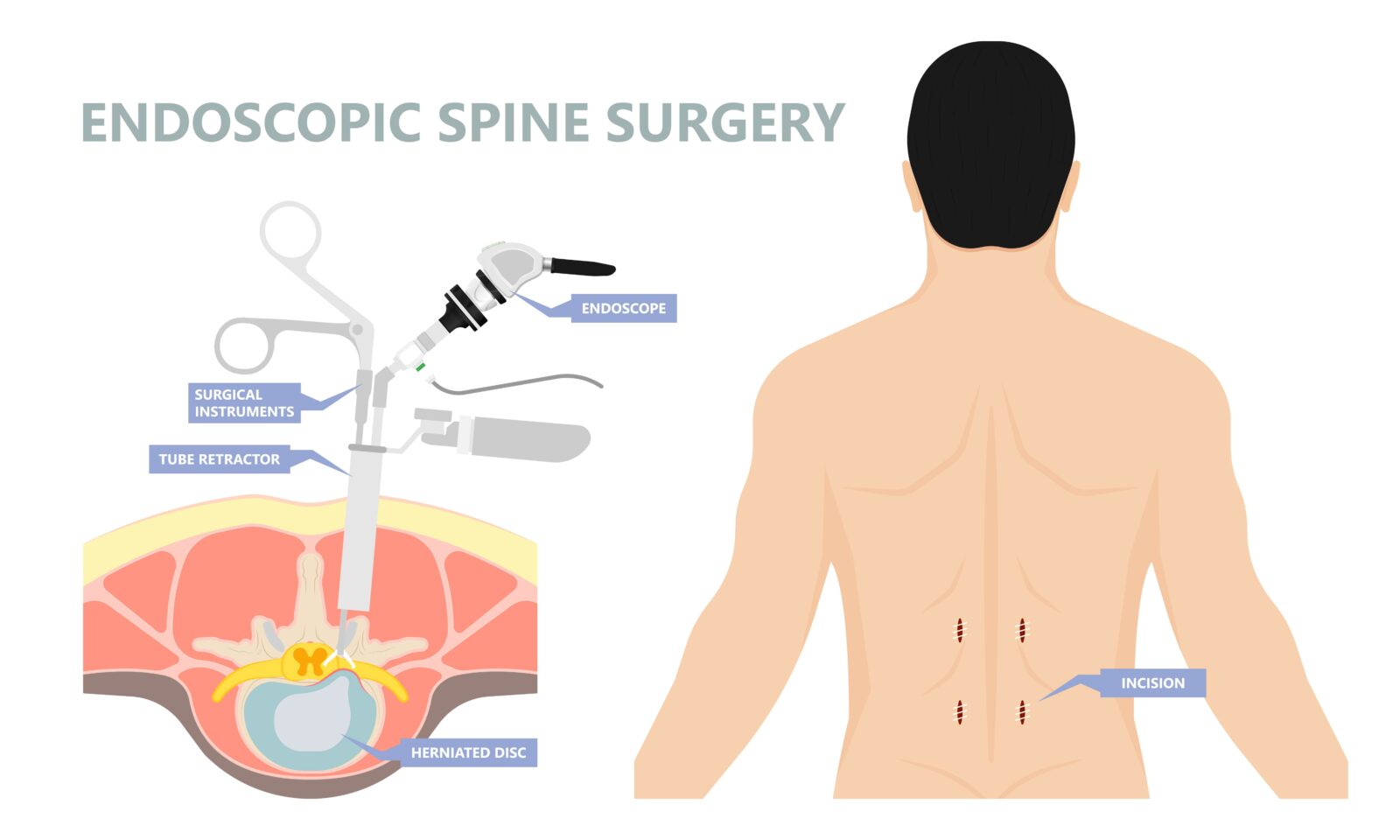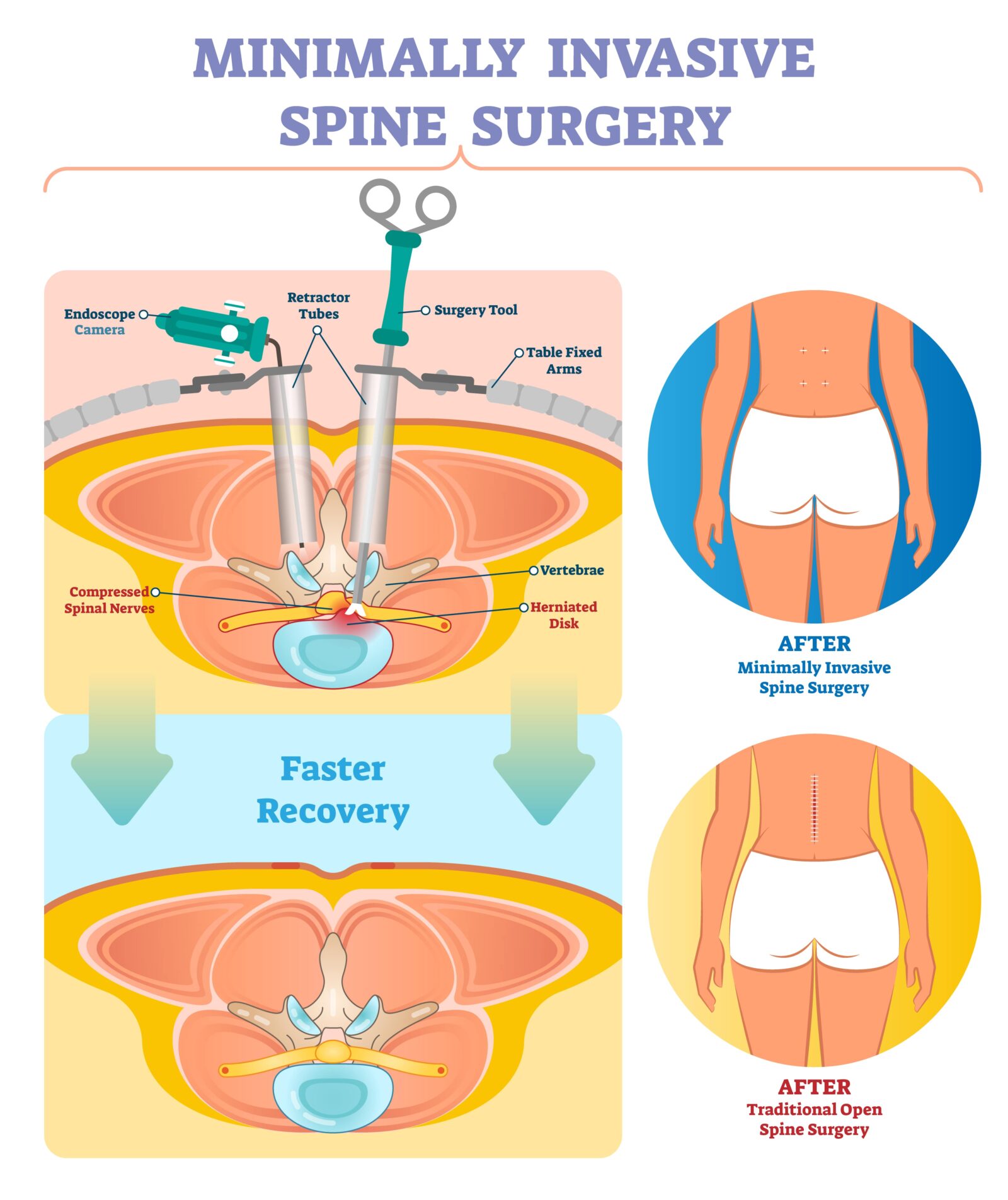Spine surgery has evolved significantly over the years, transitioning from traditional open procedures to the more advanced and less invasive techniques that characterize modern practices. Minimally Invasive Spine Surgery (MISS) represents a groundbreaking shift, offering a promising alternative that minimizes tissue damage, reduces pain, and accelerates recovery. This blog delves into the intricacies of MISS, shedding light on its myriad benefits and the various procedures it encompasses. By exploring the technological advancements that have made MISS a reality, and understanding the patient experiences and outcomes associated with these procedures, we aim to provide a comprehensive overview of this innovative approach to spine care, offering valuable insights for those considering or curious about these surgical options.
In This Blog:
- Understanding Spine Surgery
- The Rise of Minimally Invasive Spine Surgery
- Benefits of Minimally Invasive Spine Surgery
- Common Procedures in Minimally Invasive Spine Surgery
Section 1: Understanding Spine Surgery
Overview of Spine Anatomy and Common Spinal Disorders
The spine is a complex structure central to the human body, providing support and flexibility while protecting the spinal cord. It consists of a series of vertebrae, intervertebral discs, ligaments, and muscles. Common spinal disorders include herniated discs, spinal stenosis, degenerative disc disease, and scoliosis, each causing varying degrees of pain, discomfort, and mobility issues.
Historical Perspective on Spine Surgery
Traditional spine surgery often involved large incisions, significant muscle dissection, and a lengthy recovery period. These open surgeries, while effective, came with high risks of blood loss, infection, and long-term postoperative pain. Over the decades, the field has witnessed a paradigm shift towards less invasive techniques, driven by the goal of reducing operative trauma and improving patient outcomes.
Introduction to Minimally Invasive Spine Surgery (MISS)
Minimally Invasive Spine Surgery (MISS) is a technique that utilizes smaller incisions and causes less damage to the surrounding tissues compared to traditional surgery. This approach is facilitated by the use of specialized instruments, such as tubular retractors and microscopic cameras, allowing surgeons to access and treat the affected spinal area with more precision. MISS aims to reduce hospital stay duration, decrease postoperative pain, and speed up the recovery process, making spine surgery more accessible and tolerable for patients. Through MISS, surgeons can address a range of spinal disorders, offering a tailored treatment that emphasizes patient safety and positive surgical outcomes.
Section 2: The Rise of Minimally Invasive Spine Surgery
Comparison between Traditional Open Spine Surgery and MISS

The evolution from traditional open spine surgery to Minimally Invasive Spine Surgery (MISS) marks a significant advancement in the field. Traditional open surgery typically requires long incisions, extensive muscle dissection, and a prolonged recovery period. In contrast, MISS uses smaller incisions, causes less tissue damage, and focuses on preserving the integrity of the muscles and ligaments around the spine. This approach not only reduces the risk of infection and postoperative pain but also shortens hospital stays and facilitates quicker recovery.
Technological Advancements Facilitating MISS
The advent of sophisticated technologies has been pivotal in the rise of MISS. Advances in imaging techniques, such as MRI and CT scans, allow for precise preoperative planning. Intraoperative navigation systems and real-time imaging provide surgeons with enhanced visibility and accuracy during procedures. Furthermore, the development of specialized tools and instruments, including tubular retractors and endoscopes, has enabled surgeons to perform complex spinal surgeries through smaller incisions with minimal disruption to surrounding tissues.
Key Factors Driving the Adoption of MISS
Several factors contribute to the growing preference for MISS over traditional methods. The most compelling is the improved patient outcomes associated with minimally invasive techniques, including less postoperative pain, reduced blood loss, and lower infection rates. Additionally, the shorter hospitalization requirement and faster return to daily activities make MISS a more attractive option for patients. From a healthcare perspective, the cost-effectiveness of MISS, due to reduced postoperative care and quicker patient turnover, further encourages its adoption. Surgeons are also increasingly favoring MISS due to its ability to address a wide range of spinal conditions with more precision and less risk, ultimately leading to better patient satisfaction and outcomes.
Section 3: Benefits of Minimally Invasive Spine Surgery
Reduced Trauma to Muscles and Soft Tissues
One of the most significant advantages of Minimally Invasive Spine Surgery (MISS) is the reduced trauma to muscles and soft tissues surrounding the spine. Unlike traditional surgery, which often requires cutting through muscle to access the spinal column, MISS utilizes small incisions and muscle-sparing techniques. This approach leads to less tissue damage and can result in a faster and less painful recovery process.
Decreased Postoperative Pain and Discomfort

Patients who undergo MISS typically experience less postoperative pain and discomfort compared to those who have traditional open spine surgery. The minimally invasive approach, with its smaller incisions and reduced tissue disruption, minimizes the post-surgical pain. Consequently, patients often require fewer pain medications after surgery, reducing the risks associated with pain management, such as opioid dependency.
Shorter Hospital Stays and Quicker Recovery Times
MISS is associated with shorter hospital stays, allowing patients to return home sooner after their surgery. The quicker recovery times are due in part to the less invasive nature of the procedure, which leads to fewer complications and a faster return to normal activities. This not only improves the patient’s quality of life post-surgery but also reduces healthcare costs related to extended hospital stays.
Lower Risk of Complications and Infections
The minimally invasive approach of MISS results in a lower risk of surgical complications and infections. The smaller incisions reduce the exposure of internal tissues to potential external contaminants, thereby decreasing the risk of postoperative infections. Additionally, the reduced tissue trauma and blood loss during surgery contribute to a lower likelihood of complications, such as blood clots and significant blood loss.
Improved Surgical Accuracy and Outcomes
The use of advanced imaging techniques and specialized surgical instruments in MISS allows for greater surgical accuracy. Surgeons can better visualize the spine and navigate their instruments with precision, leading to more effective treatment of spinal conditions. This accuracy not only improves the immediate outcomes of the surgery but also contributes to better long-term results, enhancing the overall success rate of spinal procedures.
By offering these benefits, Minimally Invasive Spine Surgery presents a compelling option for patients needing spinal intervention, promising a safer procedure with improved outcomes and a quicker return to daily life.
Section 4: Common Procedures in Minimally Invasive Spine Surgery
Discectomy
A discectomy is a procedure aimed at relieving pressure on spinal nerves caused by a herniated disc. In the minimally invasive approach, the surgeon makes a small incision and uses specialized instruments to remove the portion of the disc that is impinging on the nerve. The minimally invasive discectomy results in less muscle damage and a faster recovery compared to the traditional open method. Patients can often go home the same day of surgery and typically experience significant pain relief and a quicker return to normal activities.
Laminectomy
Laminectomy involves the removal of part of the vertebral bone, called the lamina, to alleviate pressure on the spinal cord or nerves. This procedure is often performed for patients with spinal stenosis, a condition where the spinal canal narrows, compressing the nerves. Using minimally invasive techniques, the surgeon makes small incisions and uses a microscope or endoscope to remove the lamina with minimal disruption to surrounding tissues. This approach can significantly reduce recovery time and postoperative pain.
Spinal Fusion
Spinal fusion is performed to stabilize the spine by fusing two or more vertebrae together. In MISS, this procedure is done through small incisions, using guided imagery to place rods and screws that hold the vertebrae together until they fuse naturally over time. Minimally invasive spinal fusion is associated with less blood loss, lower risk of infection, and a shorter hospital stay, making it a preferred option for suitable candidates.
Other MISS Procedures: Vertebroplasty and Kyphoplasty
Vertebroplasty and kyphoplasty are procedures used to treat painful vertebral compression fractures, often due to osteoporosis. In vertebroplasty, a special cement is injected into the fractured vertebra to stabilize it. Kyphoplasty involves the insertion of a balloon before cement injection to help restore the height of the vertebra. Both procedures can be done minimally invasively, resulting in immediate pain relief and quick recovery for most patients.
Through these and other minimally invasive procedures, spine surgery has become more patient-friendly, with fewer risks and a faster return to normal life, offering effective solutions for various spinal conditions.
Conclusion
Minimally Invasive Spine Surgery (MISS) represents a significant advancement in the field of spinal health, offering patients a safer, less painful, and quicker recovery path compared to traditional open surgery. By minimizing tissue damage, reducing postoperative pain, and shortening hospital stays, MISS enhances patient outcomes and overall quality of life. As technology and surgical techniques continue to evolve, the future of spine surgery looks increasingly promising, with MISS at the forefront. Patients considering spine surgery are encouraged to discuss minimally invasive options with their healthcare providers to understand the best approach for their specific condition. Ultimately, the shift towards minimally invasive methods signifies a broader move in medicine towards patient-centered, efficient, and effective care.











 in CA by O360®
in CA by O360®